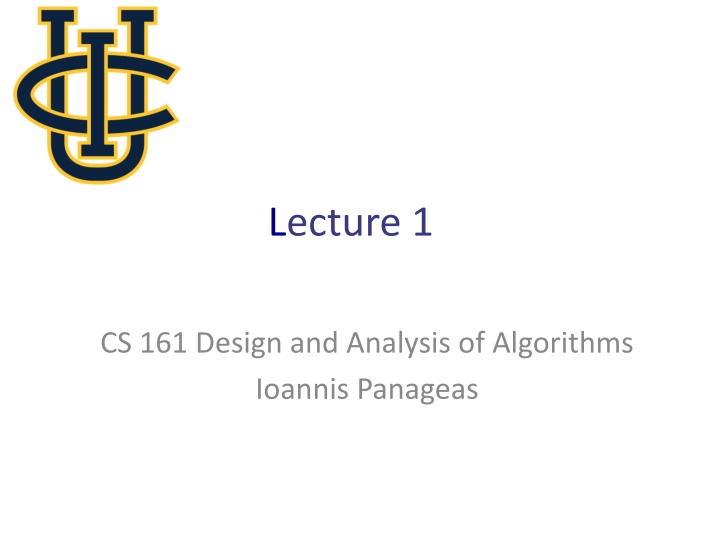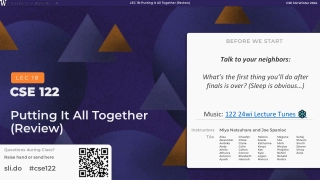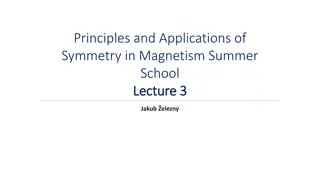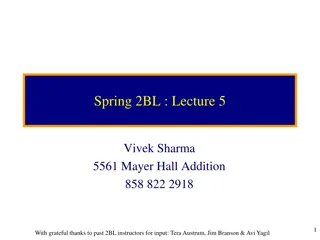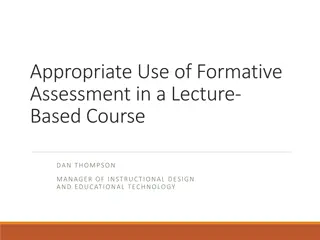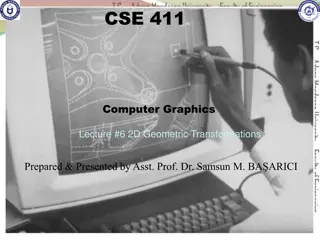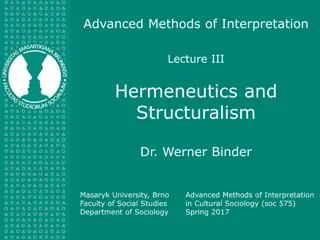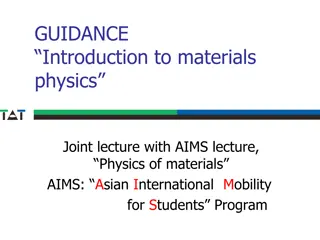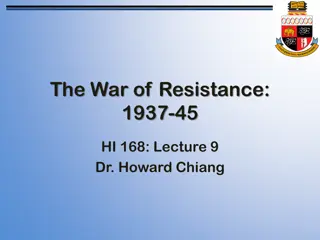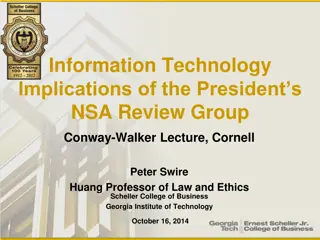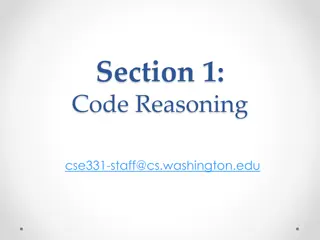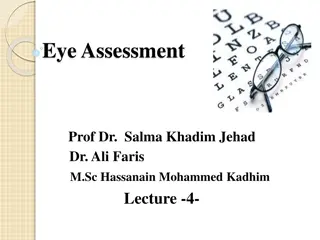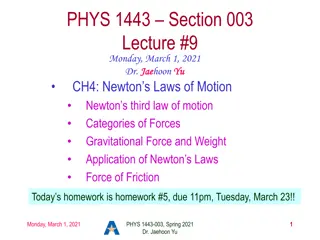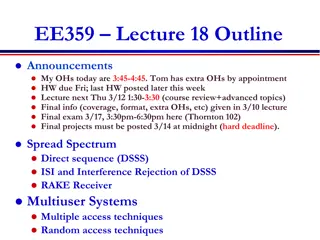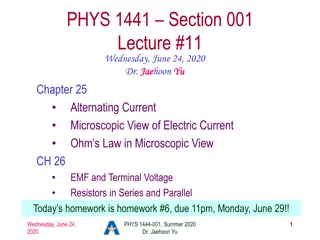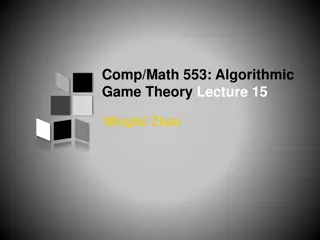Lecture 1
This detailed course overview provides information on the course staff, materials, grading criteria, letter grades, assignment submissions, and exam dates and rules for CS 161: Design and Analysis of Algorithms by Instructor Ioannis Panageas.
Download Presentation

Please find below an Image/Link to download the presentation.
The content on the website is provided AS IS for your information and personal use only. It may not be sold, licensed, or shared on other websites without obtaining consent from the author.If you encounter any issues during the download, it is possible that the publisher has removed the file from their server.
You are allowed to download the files provided on this website for personal or commercial use, subject to the condition that they are used lawfully. All files are the property of their respective owners.
The content on the website is provided AS IS for your information and personal use only. It may not be sold, licensed, or shared on other websites without obtaining consent from the author.
E N D
Presentation Transcript
Lecture 1 CS 161 Design and Analysis of Algorithms Ioannis Panageas
Course staff Instructor: Ioannis Panageas Email: ipanagea at ics dot uci dot edu Office hours: Wednesday 2:00-4:00pm (zoom) Head TA: Navin Velazco (any requests) Email: nvelazco at uci dot edu Office hours: Monday 12:00-1:00pm (zoom) TAs: Parnian Shahkar (shahkarp at uci dot edu) Office hours: Friday 5:00-6:00pm (zoom) Nikolas Patris (npatris at uci dot edu) Office hours: Wednesday 1:00-2:00pm (zoom) Stelios Stavroulakis (sstavrou at uci dot edu) Office hours: Wednesday 11:00-12:00pm (zoom) Design and Analysis of Algorithms
Course material We will use canvas for announcements. Slide materials will be posted on https://panageas.github.io/algo2024.html We will use gradescope for posting homeworks and grading. We will be using Edstem for questions of general interest about the course material, the homework, and the tests https://edstem.org/us/courses/57731/discussion/ Required Textbook Algorithm Design and Applications, by M. T. Goodrich and R. Tamassia. Recommended Textbook Introduction to Algorithms by Thomas H. Cormen, Charles E. Leiserson, Ronald L. Rivest, and Clifford Stein. Design and Analysis of Algorithms
Grading Homeworks: 20% There will be given 4 Homeworks to solve (+5% bonus for Homework 5). Midterms: 20+20+20% There will be given 3 midterms, on Tuesdays of week 4,6 and 9. Each midterm will contain topics from previous weeks. Final : 20% Material from all weeks (except last week). +1% for Course Evaluation Design and Analysis of Algorithms
Letter Grades Not a straight scale nor straight curve 90% and up guaranteed some sort of A or A- 80% and up guaranteed at least B- 70% and up guaranteed at least C- Design and Analysis of Algorithms
Submitting Assignments Written assignments in Gradescope Must be legible If you have messy handwriting, type your homework! Bonus 5% for Homework 5! Must be on-time. Deadline: Fridays 23:59pm (see syllabus) Programming assignments optional in Gradescope Code must be in python and need to pass test cases Design and Analysis of Algorithms
Exam Dates and Rules The exams are held on the days listed (syllabus) See policy in syllabus, no makeup exams Exams will not be excused for reasons within your control. If there is a valid reason (needs approval from instructor) for missing an exam, the grade will be split equally among the other components.
Academic Integrity Policy If you need help, see: Ioannis TAs Plagiarism risks an F in the class and more. The following are examples of not okay: Chegg GeeksForGeeks CourseHero Quora StackOverflow Github (generally) Chatgpt or related platform Design and Analysis of Algorithms
Collaboration with classmates You can discuss some things freely with others: What a problem is asking How to do a non-homework or non-exam problem How something from lecture worked You should never: Show your homework assignment to someone else Write your solutions from notes taken outside lecture / discussion Seek homework solutions from outside sources -- especially online! Tell a student specifically how to solve a homework problem Penalty for academic dishonesty: F in the course. Design and Analysis of Algorithms
To-Do This Week Read the syllabus Treat it as though it s a reading assignment. Main document plus associated policy documents Review Prerequisites Help is available all week, including at all discussion sections Design and Analysis of Algorithms
What is algorithm Algorithm is a procedure for solving a task e.g. how do you sort a cart of books in increasing order of the volume number? (i.e. volume 1, volume 2, volume 3 .) - Bad algorithm: compare all books, put smallest volume in the beginning and repeat. - Clever algorithm: divide the cart into two, sort the first half, sort the second half, merge them. Design and Analysis of Algorithms
What is algorithm Algorithm is a procedure for solving a task e.g. How to find the best travelling time between from a station to any other station? - Bad algorithm: manually find the travelling between each station. Clever algorithm: just record the travelling time between consecutive stations, then use the Dijkstra shortest path algorithm. - Design and Analysis of Algorithms
Case study I: Finding a Celebrity Since coming to UC Irvine, has anyone met a celebrity? Design and Analysis of Algorithms
What is a celebrity? Within a group of people G, we say a person p is a celebrity (famous) if: Everyone knows who p is (celebrities must be known by everyone) Person p does not know who anyone else is Goal: Find a celebrity from G if there exists one. Design and Analysis of Algorithms
What is a celebrity? Within a group of people G, we say a person p is a celebrity (famous) if: Everyone knows who p is (celebrities must be known by everyone) Person p does not know who anyone else is Goal: Find a celebrity from G if there exists one. You are allowed to only query if person ? knows person ? for various choices of (?,?). Design and Analysis of Algorithms
Brute force approach Given a person p we want to check if it is a celebrity How efficiently can I check if person p is a celebrity? # of queries Design and Analysis of Algorithms
Brute force approach Given a person p we want to check if it is a celebrity How efficiently can I check if person p is a celebrity? # of queries Query all other persons if they know p and also if p does not know them. Design and Analysis of Algorithms
Brute force approach Given a person p we want to check if it is a celebrity How efficiently can I check if person p is a celebrity? # of queries Query all other persons if they know p and also if p does not know them. Design and Analysis of Algorithms
Brute force approach Given a person p we want to check if it is a celebrity How efficiently can I check if person p is a celebrity? # of queries Query all other persons if they know p and also if p does not know them. We have to do the above for all possible persons p. Design and Analysis of Algorithms
Brute force approach Given a person p we want to check if it is a celebrity How efficiently can I check if person p is a celebrity? # of queries Query all other persons if they know p and also if p does not know them. We have to do the above for all possible persons p. Design and Analysis of Algorithms
Brute force approach Given a person p we want to check if it is a celebrity How efficiently can I check if person p is a celebrity? # of queries Query all other persons if they know p and also if p does not know them. We have to do the above for all possible persons p. Can we do better? Design and Analysis of Algorithms
Faster approach Put all the members in a list (arbitrary order) Pick the first two members of the list, let p, q. Query if p knows q. Design and Analysis of Algorithms
Faster approach Put all the members in a list (arbitrary order) Pick the first two members of the list, let p, q. Query if p knows q. 2 Cases: 1. 2. p knows q. Then p is not a celebrity (remove p from the list). p does not know q. Then q is not a celebrity (remove q from the list). Design and Analysis of Algorithms
Faster approach Put all the members in a list (arbitrary order) Pick the first two members of the list, let p, q. Query if p knows q. 2 Cases: 1. 2. p knows q. Then p is not a celebrity (remove p from the list). p does not know q. Then q is not a celebrity (remove q from the list). Repeat the above process. At every iterate, we remove one person. Design and Analysis of Algorithms
Faster approach Put all the members in a list (arbitrary order) Pick the first two members of the list, let p, q. Query if p knows q. Repeat the above process. At every iterate, we remove one person. Check if this remaining person is a celebrity. Design and Analysis of Algorithms
Faster approach Put all the members in a list (arbitrary order) Pick the first two members of the list, let p, q. Query if p knows q. Repeat the above process. At every iterate, we remove one person. Check if this remaining person is a celebrity. Why do you need to check? Design and Analysis of Algorithms
Faster approach Put all the members in a list (arbitrary order) Pick the first two members of the list, let p, q. Query if p knows q. Repeat the above process. At every iterate, we remove one person. Check if this remaining person is a celebrity. Why do you need to check? Design and Analysis of Algorithms
Case study II: Finding the heaviest and lightest item We are given a set of n items of different weights: ?1,?2, ,?? Goal: Find the heaviest and the lightest item. Design and Analysis of Algorithms
Case study II: Finding the heaviest and lightest item We are given a set of n items of different weights: ?1,?2, ,?? Goal: Find the heaviest and the lightest item. You are allowed to only compare ?? with ?? for various choices of ?,?. Design and Analysis of Algorithms
Brute force approach Find the heaviest item among ?1,?2, ,??. How many comparisons? Design and Analysis of Algorithms
Brute force approach Find the heaviest item among ?1,?2, ,??. ? 1 Design and Analysis of Algorithms
Brute force approach Find the heaviest item among ?1,?2, ,??. Find the lightest item among ?1,?2, ,??. How many comparisons? ? 1 Design and Analysis of Algorithms
Brute force approach Find the heaviest item among ?1,?2, ,??. Find the lightest item among ?1,?2, ,??. ? 1 ? 1 Design and Analysis of Algorithms
Brute force approach Find the heaviest item among ?1,?2, ,??. Find the lightest item among ?1,?2, ,??. ? 1 ? 1 Total number of comparisons 2(? 1). Design and Analysis of Algorithms
Brute force approach Find the heaviest item among ?1,?2, ,??. Find the lightest item among ?1,?2, ,??. ? 1 ? 1 Total number of comparisons 2(? 1). You may get 2? 3. Can we do better? Design and Analysis of Algorithms
Faster approach Compare ?1 with ?2, ?3 with ?4 etc (like round 1 of knock-out tournament). Total number of comparisons ? 2. Design and Analysis of Algorithms
Faster approach Compare ?1 with ?2, ?3 with ?4 etc (like round 1 of knock-out tournament). Total number of comparisons ? 2. Find heaviest among winners of round 1. Design and Analysis of Algorithms
Faster approach Compare ?1 with ?2, ?3 with ?4 etc (like round 1 of knock-out tournament). Total number of comparisons ? 2. ? 2 1 Find heaviest among winners of round 1. Design and Analysis of Algorithms
Faster approach Compare ?1 with ?2, ?3 with ?4 etc (like round 1 of knock-out tournament). Total number of comparisons ? 2. ? 2 1 Find heaviest among winners of round 1. ? 2 1 Find lightest among losers of round 1. Design and Analysis of Algorithms
Faster approach Compare ?1 with ?2, ?3 with ?4 etc (like round 1 of knock-out tournament). Total number of comparisons ? 2. ? 2 1 Find heaviest among winners of round 1. ? 2 1 Find lightest among losers of round 1. # comparisons ?? ? - 2 Design and Analysis of Algorithms
